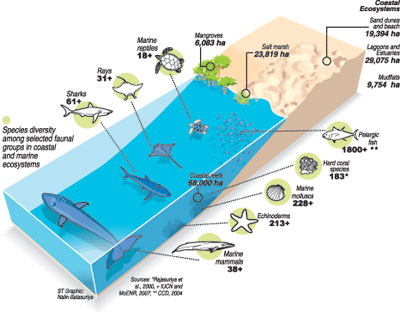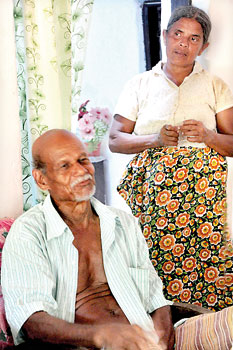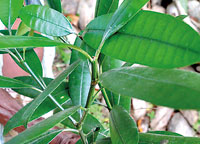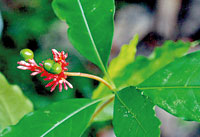| If over-fishing continues, commercial marine species could go the way of Lanka’s legendary pearl fisheries, which died out completely, warns environmentalist. |
|
| Malaka Rodrigo reports | |
Over-fishing
is reducing fish populations to dangerously low levels in the Indian
Ocean and seas around the world, warned fisheries experts.
Dr. Rekha Maldeniya of the National Aquatic
Resources Research and Development Agency (NARA) delivered the keynote
speech at a seminar on Marine Biodiversity, on May 22, which was
designated the International Day on Biological Diversity.
Over-fishing led to the demise of the pearl oyster stocks, in Mannar, Dr. Maldeniya reminded the audience. Sri Lanka was once famous for its pearls, but that industry has died out completely, and the same fate awaits other fish species unless precaution is taken, she said. Management decisions are being delayed by a lack of sufficient data for a good understanding of the country’s coastal and marine ecosystems. “There is a lot of ongoing research on land-based ecosystems, but not enough research on marine ecosystems. Marine biodiversity research is expensive, and we do not have enough trained people to do the research. Even the little research output we have, such as the Environmental Impact Assessments, is under-utilised. While our main concern is commercially valuable fish species, other marine creatures are also under great pressure.” Weak enforcement of laws and regulations has also contributed to the decline in coastal fish stocks. Dynamiting and the continued use of banned types of fishing nets must end if fish stocks are to be maintained. Some countries use large nets such as the purse seine to catch tons of fish. Such action depletes stocks very quickly. Taking management action, the expert said, is not easy, as many fish stocks overlap ocean areas belonging to different countries. Some pelagic fish, like tuna, are migratory, so protection by one country alone does not ensure a species’ survival. All marine habitats are interconnected. For example, certain marine fish come to estuaries to breed, and if the estuaries are not protected, the species is threatened. Habitat loss, degradation and fragmentation, destructive fishing methods, pollution, the spread of invasive alien species – all are serious threats to marine life. Sri Lanka exports 20,000 metric tons of fish a year. A total of 650,000 people are employed in the fisheries industry, including 150,000 fishermen, 100,000 in fishing-related services, and 400,000 in the fish trade. Up to 2.4 million persons are sustained by fish consumption. Fish species contribute to 70 per cent of the country’s animal protein consumption. How much life is there in the sea? The marine biodiversity found around Sri Lanka ranges from microscopic algae to the giant Blue whale. During a 10-year period, from 2000 to 2010, scientists around the world collaborated in an unprecedented effort to determine how much life there is in the sea. The Census of Marine Life, carried out under the Convention of Biodiversity, involved 2,700 scientists from more than 80 countries. They studied surface seawater and probed the deepest, darkest depths of the ocean, sailed tropical seas and explored ice-strewn oceans in the Arctic and the Antarctic. By the time the census was concluded, a total of 1,200 new species had been added to the known roster of life in the sea. Scientists are still working their way through another 5,000 specimens to determine whether they are new discoveries. The number of known marine species is estimated at around 250,000. In its final report, the census team suggested the number could be at least a million, while others believe the figure could be double that. Source:http://www.sundaytimes.lk/120527/News/nws_24.html |
Sri Lanka is a beautiful country in Indian ocean with rich Bio diversity.Because of various human activities,that rich bio diversity is in near extinct.
Sunday, May 27, 2012
Ocean fish populations dropping to alarmingly low levels
There’s a bark for every snakebite: Banda veda
| E.M.Banda from a remote village in the hills says he has cured more than 3,000 snakebite victims | |||||
| By Wasantha Ramanayake | |||||
|
He is a simple old man from a remote village,
claiming to have cured/saved more than 3,000 snakebite victims, free of
charge. It is not because he is rich, but considers it unethical to
charge a fee from a person who is already in distress. E.M. Banda, 84, is a native snakebite doctor, residing in a simple house, “Veda Nivasa”, in Wagolla, Palle-Inguruwatte, Inguruwatte, Mawathagama, among hills accessible via a difficult narrow road, a few kilometres away from Watareka junction, on the Mawathagama-Rambukkana road.
He was born in 1929, and studied at Watareka School, a few kilometres from his home. His mother died when he was 16. He could still remember how the children, biting a piece of stick, crawled into trenches, to hide from the Japanese bombers.His father, E.M. Dingiri Banda was a famous native snakebite doctor. There were four children, two girls and two boys. Banda was the only child who followed in his father’s footsteps, to become a native doctor. “Father always said that I could not be a good doctor, he always expected more from me,” he said. His father died in 1967. Banda claims to have effective snake-charms against cobras and mapilas. For cobras, he would sprinkle sand, on which a charm has been recited, around the compound of the house, which will make it out of bounds for reptiles. For mapilas, it is a written charm that hung on the wall. According to him, deadly venomous snakes are a number of mapila species, cobras, vipers, and kraits. “When there’s protection, even a mongoose could not come into the compound,” he said. “None whom I have treated to date, have died,” he declared. He could not say how many patients he had treated, but believes it could be more than 3,000, since he began practising,” he added. He said it is difficult to treat a person who was unconscious. “First I use nasnaya, a mixture of herbs to treat those who are unconscious, and once the person regains consciousness, he could be treated. I have never sent anybody to government hospitals for treatment,”he said. Commenting on not charging a fees he said, “How can I charge a fee from someone who is in distress? But of course, most of them visit me with gifts, after they are cured.” He cultivates paddy and has a banana cultivation, although the market is very poor, he says. His elder brother lives in Kurunegala, looking after his rubber trees and gets an income. “I always work. I am used to working a lot,” he said. “A snakebite victim fears for his life. Calm the victim and make him/her lie down, assuring of a doctor’s attention soon. Then apply some lemon on the bite, and apply a tourniquet above the bite, with a hair,” says Dingiri Banda when discussing first aid steps. He said a strip of bark from the thel endaru (castor oil) tree could be used to tie up the place just above the bite. Medical assistance should be sought immediately. He does not recommend washing with water. His advice is to avoid places frequented by snakes such as termite hills, undergrowths and to light one’s way at night. He said there is a proven first aid to spider as well as snakebites. “Take divi kaduru (Eve’s apple) leaves, peel the bark of the tree and some raw turmeric and common salt. Pound them in a mortar and heat the mixture in a pan. Apply the mixture on the bite. This could relieve the pain,” he said. For paththaya or centipede bite, ekaweriya (rauwolfiaroot) leaves with lemon juice, and for wasp attacks karanda roots should be ground with lemon juice. For spider-bites, he recommends thinly sliced divipahuru leaves mixed with raw, ground turmeric and salt mixture to be mildly heated and applied on the bite.
“It is a pity that most young people today do not know what the trees and plants around them are,” he lamented. He said that certain plants are difficult to find. “Twenty- thirty years ago, there were fewer houses and trees and plants were everywhere,” he added. He has some of the medicinal plants in his home garden. “Earlier, people knew most of the medicinal plants, because they took native treatment. They were not used to western medicines, as they have to go a long way to a Government hospital,” he observed. Answering the question whether snakes shouldbe spared, he said, “They should not be killed, they are part of our world. Generally, snakes do not bite, unless somebody steps on them accidentally, or handles them. But there are occasions when they could be angry because they are disturbed while mating or if you happen to cross their paths, when they are after some prey,” he said. He said there are less snakes in their home gardens now, as there are more houses and open spaces. But there are more snakes during the rainy season, and also during the paddy harvesting season in paddy fields and also in rubber estates. Commenting on who will succeed him in the line of curing snakebite victims, he said he has three daughters of whom one lives in Polpithigama in the Kurunegala district, who does some practice. The other two are afraid to take on the responsibility he says. “My daughter-in-law however is competent and confident. She can treat and also knows some charms,” he revealed. He said that many have expressed the wish to share his knowledge, but he has already decided who should carryon his work. “It should be my daughter-in-law, otherwise there would be a conflict of interest,” he said. When it comes to his own wellbeing he said he did not usually take medication for any ailment. Once in away he takes a paracetamol. But mostly, he uses herbs and herbal medicine. He would boil a mixture of garlic, uluhaal (fenugreek seeds) and pepper together in a pot of water and drink it for any stomach ache. Source:http://www.sundaytimes.lk/120527/News/nws_26.html |
DWLC conducts probe into army shooting on jumbos
The Department of Wildlife and Conservation (DWLC) has launched an
investigation why the army shot two wild elephants in Bundala yesterday.
According to environmentalists one jumbo was shot in the head and the other sustain similar gun shot injuries.
Meanwhile, DWLC Veterinary surgeon Dr Vijitha Perera had rushed to the scene to treat the injured animals. It was found one elephant had killed a girl in a village of Bundala and also injured her father two days ago.
Source:http://www.sundayobserver.lk/2012/05/27/oostory.asp?sid=20120224_01&imid=shoot.jpg&dt=[February%2024%202012]
According to environmentalists one jumbo was shot in the head and the other sustain similar gun shot injuries.
Meanwhile, DWLC Veterinary surgeon Dr Vijitha Perera had rushed to the scene to treat the injured animals. It was found one elephant had killed a girl in a village of Bundala and also injured her father two days ago.
Source:http://www.sundayobserver.lk/2012/05/27/oostory.asp?sid=20120224_01&imid=shoot.jpg&dt=[February%2024%202012]
Subscribe to:
Posts (Atom)



